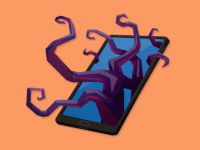Myth vs. Reality in a 1:1 Classroom
Three myths about the 1:1 classroom: it’s a paperless environment; all student work happens on devices; and all teachers need to adopt the technology.
Editor's note: Karla Evers, an English teacher at Grafton High School (Grafton, Massachusetts) co-authored this post.
Four years ago, I was part of a major transition in classroom and instructional design. The disruptor was in the form of an iPad. This device was making its foray into the classroom for the first time, and in my experience, it would end up in the hands of every student and teacher. Over the last four years, I've noticed several trends and themes that have surrounded the iPad -- most notably, that the device itself was a driving force in classroom instruction. This could not be further from the truth.
What the iPad, or any web-enabled device for that matter, allows us to do in the classroom is build upon the convergence of powerful hardware and dynamic teaching. Teachers need to begin seeing the new tools as supplements to what they're already doing really well. Additionally, when planning in a 1:1 or connected classroom, teachers need to consider all movable pieces in their instructional design. I would argue that the arrangement of the desks is just as important as the device itself. What the device and its applications really allow teachers to do is challenge students in new ways. It opens up new avenues in instructional designs and revises the role of the teacher to more of a facilitator for learning.
At Grafton High School, I am lucky to witness this daily in the classrooms that I pass through. I never see the same learning design and will occasionally see all devices out at once. Below are three myths about 1:1 learning environments from Grafton HS English teacher Karla Evers. Karla explores these myths while sharing her experiences of teaching in this environment for the last three years.
Myth #1: All things paper go the way of the dinosaur.
When districts plan for a 1:1 rollout, inevitably the crunching of numbers includes a reduction in copy paper and textbooks. And won't it be great when we go entirely green? The reality is that those very same district budgets, as well as copyright laws, mandate that those same old books in the closet continue to be used. Sometimes, good instruction involves writing an essay in longhand, annotating on a hard copy with highlighters and pens, and yes, making a poster to show understanding. Of course, taking full advantage of creating and learning on a device makes sense, but we can't deny the real cost factors and, more importantly, the learning advantages of using non-virtual tools.
Myth #2: All student work should be done on the device.
As a teacher three years into the 1:1 device program at our school, I've learned a lot about how students work in this atmosphere. The most important takeaway at this point is that just like BD (before devices), students learn differently. While it is certainly possible to do nearly all schoolwork on a device, it is not the best way for many students to learn.
As an example, for a recent unit on Romeo and Juliet, students were asked to establish the rules of Verona, Italy, where Shakespeare's play is set. For this task, students were to create a poster that reflected those rules and provide evidence from the primary text as well as two associated non-fiction articles to support their chosen rules. Every piece of the project could have been done on the iPad, from annotation to the poster. However, many students have a hard time switching back and forth between the virtual text screens and efficiently culling needed information. Having a hard copy of the articles while being able to toggle through the online play and assignment parameters worked better for some. Collaborating to create a poster on poster board was much more effective for our learning when these products could be posted for a gallery walk and peer assessment with sticky notes.
As teachers, we must always do what's best for students as a diverse set of learners. Sometimes that means using alternate ways to transfer information and complete learning activities with materials that may or may not include a device.
Myth #3: Teachers must hurry up and get in the game.
Just like our students, every teacher's comfort level with technology varies. The notion that every faculty member must jump into the digital pool quickly, efficiently, and with the same amount of passion for technological change is detrimental. Teacher buy-in, and ultimately the success of educators to support their curriculum and teaching with technology, rests with district leaders who must meet teachers where they are and not promote some idealized version of what 1:1 really looks like. The goal of the school district needs to be supporting each teacher in his or her tech growth with training that is content specific and tiered to the levels of ability. We differentiate for our students, and we need to do the same for our instructors.
The biggest mistake a school or district can make when going 1:1 or bringing in any type of new technology is to focus all of the time and professional learning around applications or hardware. There should be a healthy balance of the two. What's more, edtech consultants will focus on app smashing and devices rather than preparing teachers for rethinking or evolving their instructional design process. The best approach for teachers is to plan and design their lessons at the intersection of instruction and technology. And sometimes the technology won't even need to be planned -- it will just naturally occur. The key, despite the technology involved, is to challenge students and provoke their learning by making the device necessary and meaningful to solving a problem or developing a solution.
